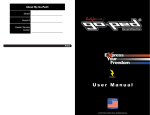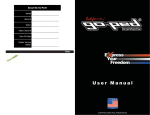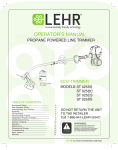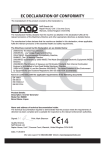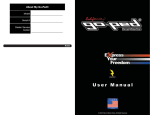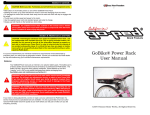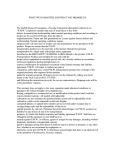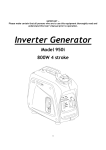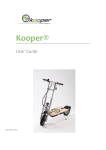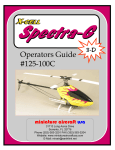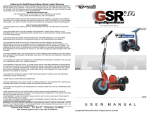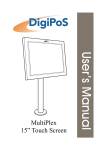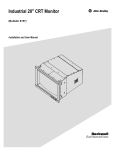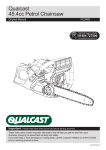Download Motor Serial - Electric Scooters Galore
Transcript
About My Go-Ped® Model _______________________ Serial # _______________________ Motor _______________________ Motor Serial # _______________________ Gas:Oil Ratio _______________________ Dealer Service Center _______________________ Notes WHAT WE GUARANTEE AND WHAT YOU PROMISE US Patmont Motor Werks, a Nevada Corporation (hereinafter referred to as “P.M.W.”) expressly warrants that each of its products is free from defects in material and workmanship under normal operating conditions and according to proper use for a period of 90 days from the date of original purchase. Frame and fork guaranteed for 2 years against factory defects and workmanship. Normal operating conditions require adequate fuel / oil ratio and / or routine care and maintenance by the purchaser of the product. Proper use means that the P.M.W. transportation product is to be used only in the manner intended for personal transportation of a single rider with proper safety equipment described on the RED SAFETY WARNING LABEL affixed to the product. P.M.W. Transportation Products are intended for use only with the proper safety equipment on smoothly paved, safe, dry, nonoily surfaces in accordance with local regulations during daylight hours. In express consideration for purchasers execution of the limited warranty and liability agreement, P.M.W. will repair or replace any part or component, other than tires, of the P.M.W. transportation product free of charge to the original purchaser who registers his/her product under the warranty program. Warranty service can be obtained by calling your local dealer or the Tech. Line at (925) 3737827 and following the instructions given by the service representative. Shipping costs will be at the purchasers’ expense. This warranty does not apply to tire wear, operation under abnormal conditions or damage to the vehicle brought on by improper use. Racing, competitive or commercial use, or modification of the product shall void this express limited warranty. The propane powered LEHR 25cc four stroke engine has a 2 year warranty towards any manufacturing defect. If you have any questions regarding your LEHR engine warranty coverage, need engine service, or to obtain a list of authorized LEHR engine service dealers, you should contact LEHR at 1866 941LEHR or vist the LEHR website at www.golehr.com. Purchaser herewith acknowledges: (a) P.M.W. assumes no liability for any misuse of any of its transportation products. (b) Under this limited warranty and liability agreement P.M.W. shall have no obligation and the purchaser or user shall have no remedy against P.M.W., its officers, agents or assigns for any damages, including without limitation, incidental, consequential, special, punitive damages arising from direct or indirect injury to person or property, or any other loss, whether or not occasioned by negligence, or otherwise, on the part of P.M.W. (c) Purchaser acknowledges that there is an inherent risk in the operation of motorcycles, bicycles, mopeds, and all P.M.W. transportation products, and herewith assumes the risk of any injury arising from operation of any P.M.W. transportation product. Original owner will indemnify and hold P.M.W. harmless and will take full responsibility for conveying all safety warnings, instructions, and limited warranty if unit is sold, lent, or otherwise transferred to other persons and will indemnify P.M.W. from any claims against it for original owners’ failure to do so. THE EXPRESS LIMITED WARRANTY DESCRIBED ABOVE SHALL BE EXCLUSIVE AND THERE IS NO OTHER WAR RANTY OR LIABILITY, EXPRESS OR IMPLIED, ARISING BY LAW OR OTHERWISE AND WHETHER OR NOT OCCASIONED BY SELLER’S NEGLIGENCE. THERE IS NO IMPLIED WARRANTY OF MERCHANTABILITY OR FITNESS FOR A PARTICULAR PURPOSE. THERE ARE NO WARRANTIES WHICH EXTEND BEYOND THOSE EXPRESSLY STATED HEREIN. NOTICE: Some states do not allow the exclusion or limitation of incidental or consequential damages and some states do not allow limitation on how long an implied warranty lasts, therefore, some of the above limitations may not apply to you. NOTICE: Your Homeowners Insurance may not cover either Direct or Third Party Liability Claims arising from use of this or any other Go Ped® product. PLEASE ACKNOWLEDGE THAT YOU HAVE READ AND UNDERSTAND EACH WARNING BY PLACING YOUR INITIALS IN EACH BOX ______ This device does not conform to Federal Motor Vehicle Safety standards and is not intended for operation on public streets, roads or highways. ______ Safety helmet, goggles, gloves, elbow, and knee pads, appropriate shoes, and bright clothing must be worn while operating this device to reduce potential of injury. ______ Do not operate this device in traffic, or on wet, frozen, oily or unpaved surfaces. Avoid uneven surfaces, chuckholes, surface cracks, obstacles and night or conditions of darkness. ______ Never carry passengers and objects that can hinder your abilities to safely operate your vehicle. ______ Pregnant persons should not use this product. ______ Never use alcohol or drugs before or while operating this device. They slow reaction time and impair judgment. ______ This product should not be used by minors without adult supervision. ______ High speeds, jumps and trick maneuvers are dangerous and could result in loss of control and other accidents. ______ When accelerating or climbing hills, you will need to lean forward, under braking conditions you will need to lean back, to keep wheels in contact with the ground. ______ Never permit a guest to use this device unless the guest has read the user manual and all labels. ______ I agree to provide my guest with helmet, safety goggles, elbow pads, and knee pads. ______ Engine shut off switch is available for rear wheel braking or for use in the event of throttle failure or other emergency when engine shut off is desired. ______ This product should not be used by persons unwilling or unable to take responsibility for their own actions. ______ Read all additional warnings and instructions in user manual before operating this P.M.W. product. ______ Adults purchasing this Unit for Children, inclusive but not limited to a Parent or Guardian, assume direct liability for injury to the child, or to third parties to whom the child entrusts the vehicle. ______ Homeowners Insurance may not cover either Direct or Third Party Liability Claims Arising from Use of this or any other GoPed® product. ______ I herewith promise not to entrust this vehicle to any child under 16 (Sixteen) years of age. ______ Never remove exhaust tube from manifold of engine or serious damage to your GoPed and yourself will result. WE SETTLE ARGUMENTS BY ARBITRATION ANY DISPUTE HEREUNDER WILL BE RESOLVED THROUGH BINDING ARBITRATION IN THE CITY OF RENO, COUNTY OF WASHOE, NEVADA, ACCORDING TO THE RULES GERMANE TO ARBITRATIONS CONTAINED IN REVISED NEVADA STATUTES. California GoPed®/Patmont Motor Werks Limited Warranty EMISSION RELATED PARTS, FOR TWO (2) YEARS FROM THE DATE OF ORIGINAL DELIVERY, PATMONT MOTOR WERKS (THE COMPANY), THROUGH ANY GOPED® DEALER, WILL REPAIR OR REPLACE, FREE OF CHARGE, FOR THE ORIGINAL AND EACH SUBSEQUENT PURCHASER, ANY PART OR PARTS FOUND TO BE DEFECTIVE IN MATERIAL AND/OR WORKMANSHIP, EMISSIONRELATED PARTS ARE: THE CARBURETOR ASSY, COIL ASSY, ROTOR, SPARKPLUG, AIR FILTER, FUEL FILTER, INTAKE MANIFOLD, AND THE GASKETS ALL OTHER PARTS EXCEPT ABOVE PARTS, FROM THE DATE OF ORIGINAL DELIVERY, THE COMPANY, THROUGH ANY GOPED® DEALER WILL REPAIR OR REPLACE, FREE OF CHARGE, FOR THE ORIGINAL PURCHASER. ANY PART OF PARTS FOUND TO BE DEFECTIVE IN MATERIAL AND/OR WORKMANSHIP. THIS IS THE EXCLUSIVE REMEDY: THE PURCHASER SHALL BEAR COSTS OF TRANSPORTING THE UNIT TO AND FROM THE GOPED® DEALER. THE PURCHASER SHALL NOT BE CHARGED FOR DIAGNOSTIC LABOR WHICH LEADS TO THE DETERMINATION THAT A WARRANTED PART IS DEFECTIVE, IF THE DIAGNOSTIC WORK IS PERFORMED AT THE GOPED® DEALER. THE PURCHASER OR OWNER IS RESPONSIBLE FOR THE PERFORMANCE OF THE REQUIRED MAINTENANCE AS DEFINED BY THE MANUFACTURER IN THE OWNER/OPERATOR MANUAL. ANY WARRANTED PART WHICH IS NOT SCHEDULED FOR REPLACEMENT AS REQUIRED MAINTENANCE, OR WHICH IS SCHEDULED ONLY FOR REGULAR INSPECTION TO THE EFFECT OF “REPAIR OR REPLACE AS NECESSARY” SHALL BE WARRANTED FOR THE WARRANTY PERIOD. ANY WARRANTED PART WHICH IS SCHEDULED FOR REPLACEMENT AS REQUIRED MAINTENANCE SHALL BE WARRANTED FOR THE PERIOD OF TIME UP TO THE FIRST SCHEDULED REPLACEMENT POINT FOR THE PART. ANY REPLACEMENT PART THAT IS EQUIVALENT IN PERFORMANCE AND DURABILITY MAY BE USED IN NONWARRANTY MAINTENANCE OR REPAIRS, AND SHALL NOT REDUCE THE WARRANTY OBLIGATION OF THE COMPANY. THE COMPANY IS LIABLE FOR DAMAGES TO OTHER ENGINE COMPONENTS CAUSED BY THE FAILURE OF A WARRANTED PART STILL UNDER WARRANTY. THE WARRANTY DOES NOT APPLY TO THOSE UNITS WHICH HAVE BEEN DAMAGED BY NEGLIGENCE OF INSTRUCTION LISTED IN THE OWNER/OPERATOR MANUAL FOR PROPER USE AND MAINTENANCE OF THE UNIT, ACCIDENT, MISHANDLING, ALTERATION, ABUSE, IMPROPER LUBRICATION, USE OF ANY PARTS OR ACCESSORIES OTHER THAN THOSE SPECIFIED BY THE COMPANY, OR OTHER CAUSES BEYOND THE COMPANY’S CONTROL. THIS WARRANTY DOES NOT COVER THOSE PARTS REPLACED BY NORMAL WEAR OR HARMLESS CHANGES IN THEIR APPEARANCE. THERE ARE NO OTHER EXPRESS WARRANTIES. IMPLIED WARRANTIES INCLUDING THOSE OF MERCHANTABILITY AND FITNESS FOR A PARTICULAR PURPOSE ARE LIMITED TO 90 DAYS FROM THE ORIGINAL DELIVERY DATE. LIABILITIES FOR INCIDENTAL OR CONSEQUENTIAL DAMAGE UNDER ANY AND ALL WARRANTIES ARE EXCLUDED. SOME STATES DO NOT ALLOW LIMITATIONS ON HOW LONG AN IMPLIED WARRANTY LASTS OR EXCLUSION OR LIMITATION OF _________ (Purchaser’s Initials Required) NOTICE: BY SIGNING BELOW YOU ARE AGREEING TO HAVE ANY DISPUTES ARISING OUT OF THE MATTERS INCLUDED IN THE ‘ARBITRATION OF DISPUTES’ PROVISION DECIDED BY NEUTRAL ARBITRATION AS PROVIDED BY NEVADA LAW, AND THAT YOU ARE GIVING UP ANY RIGHTS YOU MIGHT POSSESS TO HAVE THE DISPUTE LITIGATED IN A COURT OR JURY TRIAL. BY SIGNING BELOW YOU ARE GIVING UP YOUR JUDICIAL RIGHTS TO DISCOVERY AND APPEAL, UNLESS THOSE RIGHTS ARE SPECIFICALLY INCLUDED IN THE ‘ARBITRATION OF DISPUTES’ PROVISION. IF YOU REFUSE TO SUBMIT TO ARBITRATION AFTER AGREEING TO THIS PROVISION, YOU MAY BE COMPELLED TO ARBITRATE UNDER THE AUTHORITY OF THE NEVADA CODE OF CIVIL PROCEDURE. YOUR AGREEMENT TO THIS ARBITRATION PROVISION IS VOLUNTARY. INCIDENTAL OR CONSEQUENTIAL DAMAGES, SO THE ABOVE LIMITATION OR EXCLUSION MAY NOT APPLY TO YOU. THIS WARRANTY GIVES YOU SPECIFIC LEGAL RIGHTS, AND YOU MAY ALSO HAVE OTHER RIGHTS WHICH VARY FROM STATE TO STATE. IF YOU NEED TO OBTAIN INFORMATION ABOUT THE NEAREST SERVICE CENTER, PLEASE CALL PATMONT MOTOR WERKS AT (925) 3737827 or visit www.goped.com You should feel free to consult an attorney before signing this limited warranty and liability agreement. IMPORTANT: YOU WILL RECEIVE A WARRANTY REGISTRATION FORM AT TIME OF PURCHASE. PLEASE FILL OUT THE FORM AND I have read understood and agreed to be bound by the limited warranty and liability agreement above and agree to submit disputes arising out of matters included in the arbitration of disputes provision to neutral arbitration. SEND IT TO GOPED®/PATMONT MOTOR WERKS WITHIN SEVEN (7) DAYS. BE SURE TO KEEP A COPY FOR YOUR RECORDS. Patmont Motor Werks P.O. Box 1209 Minden, NV 89423 Section 11: Storage, Transporting, Engine Information 11.1 Storage • Remove propane tank • Never store the unit with attached propane canister where fumes may reach an open flame or spark. • Allow engine to cool before storing. • Lock up the unit to prevent unauthorized use or damage. • Store in a dry well ventilated area. • Store out of reach from children. 11.2 Long Term Storage • As always, remove propane canister when unit is not in use. • With engine cool, remove spark plug and add 5 drops of motor oil into the cylinder. Pull starter rope to help distribute oil evenly inside the cylinder and reinstall spark plug. • Lock up the unit to prevent unauthorized use or damage in a dry well ventilated area. After long term storage, Change the oil (Section 8.2), perform a through “Mechanical Safety Check” (Section 2.2), and remove spark plug and the drain oil you put in the cylinder before starting. 11.3 Transporting • Allow the engine to cool before transporting. • Secure unit while transporting. • Remove propane canister. 11.4 Engine Information Engine Type ........................................ Air Cooled 4Cycle Displacement ...................................... 25.4cc Clutch Type .......................................... Centrifugal Operational RPM ................................ 6,8009,300 RPM Idle Speed ........................................... 3,0003,400 RPM Power ................................................... 1hp Ignition Type ........................................ Electronic Valve Clearance ................................ 0.0760.152mm (0.0030.006 in.) Spark Plug Gap .................................. 0.5mm (0.020 in.) Lubrication .......................................... SAE 10W30 Oil Crankcase Oil Capacity .................... 1.7 Fl Oz. (50 ML) Fuel ...................................................... Propane 16.4 Oz. Cannister Carburetor .......................................... Chokeless, All Position Starter .................................................. Auto Rewind Muffle ................................................... Baffled With Guard Engine Warranty The propane powered LEHR 25cc four stroke engine has a 2 year warranty towards any manufacturing defect. As a small engine owner, you are responsible for perfor mance of the required maintenance listed in your owners manual. You should be aware that LEHR may deny you warranty coverage if your engine or a part has failed due to abuse, neglect, improper maintenance, or unapproved modifications. You are responsible for presenting your LEHR engine to a LEHR service center as soon as a problem exists. If you have any questions regarding your LEHR engine warranty coverage, need engine service, or to obtain a list of authorized LEHR engine service dealers, you should contact LEHR at 1866941LEHR or vist the LEHR website at www.golehr.com. Contents Section 1: Important Information 1.1) About This Manual 1.2) A SPECIAL NOTE FOR PARENTS Section 2: Safety 2.1) Equipment Safety 2.2) Mechanical Safety Check 2.3) Scooting Safety 2.4) Rules to Scoot By 2.5) Stunts, Wheelies, or Jumps 2.6) Wet Weather Riding 2.7) Night Riding Section 3: Assembly 3.1) Preassembled Scooters 3.2) Some Assembly Required 3.3) Folding Feature Section 7: Engine Starting And Stopping 7.1) Engine Starting Instructions 7.2) Engine Stopping Instructions Section 8: Engine Maintenance 8.1) Check Oil Level 8.2) Changing the Oil 8.3) Cleaning the Air Filter 8.4) Carburetor Adjustment 8.5) Replacing the Spark Plug 8.6) Rocker Arm Clearance Adjustment Section 9: General Maintenance 9.1) Service and Maintenance Schedule Section 10: Adjustments Section 4: Engine Oil 10.1) Brake Adjustments 10.2) Wheels 10.3) Chain Tension Adjustment 10.4) Suspension Section 5: Understanding Propane Section 11: Storage, Transporting, and Engine inforamtion 4.1) Recommended Oil Types 4.2) Adding Oil to the Crankcase 5.1) Handling & Storage 5.2) Before Use 5.3) During Use 5.4) After Use 11.1) Storage 11.2) Long Term Storage 11.3) Transporting 11.4) Engine Information Section 6: Install/Remove Propane Canister 6.1) Use the Correct Propane Canister 6.2) Attaching the Propane Canister 6.3) Removing the Propane Canister Thank you for your recent acquisition of a California GoPed® brand product! We are very happy and proud to welcome you to California GoPed®, the World’s Best in Extreme Fun, Innovation and Quality. By choosing California GoPed®, you have selected the highest quality scooter products in the World, which have been handcrafted in the USA since 1985, using aircraft grade materials and the highest quality components. As the leader in innovation, design and performance California GoPed® has paved the way for personal transportation by producing lightweight, fuel efficient, durable, performance minded, and wellbalanced machines. As a new GoPed® owner and User, you now have access to the widest dealer network, thousands of parts for your GoPed®, complete warranty coverage and instant access to service. You are now part of the fastest growing community of scooter enthusiasts in the world. A technical hot line is available for further assistance 9253736309. You can also find technical help videos and replacement parts by visiting the “FAQ” and “Products” pages at www.goped.com Attention: To find more information, news, replacement parts, accessories, and support on California GoPed® Brand Products, please visit us online at www.goped.com. You can also become a “GoPed Brand Products” fan on FaceBook, follow us on Twitter “Go_Ped” and or connect, have discussions or just see what other GoPed owners and fans are saying at www.gopednatiion.com Section 1: Important Information 1.1 About this Manual Why you should read this manual: This manual was written to help you understand the operation and maintenance of your vehicle. It’s important for you to understand your new scooter/kart, its features and operations so that from your first ride you will get the most from your new scooter/kart and form proper habits to keep it maintained for optimum performance and safety for many years to come. Keep this manual. Refer to it often and use it to instruct other users. If you loan out your GoPed® also loan them this manual. It is also important that your first ride on a new scooter/kart is taken in a controlled environment, away from vehicles, obstacles and other hazards. Even if you have previous experience with motorized scooters, vehicles, bikes, and the like, you probably need an update of your scooting habits, knowledge and assumptions. There are many changes in technologies and construction which can affect function, handling, performance and safety of your scooter/kart. General Warning: Scooting/karting can be a hazardous activity even under the best of circumstances. Proper maintenance of your scooter/kart is your responsibility as it helps reduce the risk of injury. This manual con tains many “Warnings” and “Cautions” concerning the possible conse quences of failure to follow instructions, perform maintenance, or inspect your scooter. Any fall can result in serious injury or even death, so operat ing within the guidelines outlined in this manual will help reduce those ris ks. Attention: • The status of the GoPed® as a “motor vehicle” varies from state to state and is subject to drivers licensing, insurance requirements and registration. • You should check with a reliable authority in your state to see if the GoPed® must be registered as a motor vehicle. Your police department or local department of motor vehicles may be able to answer your questions or direct you to a reliable authority. • Your insurance policies may not provide coverage for accidents involving the use of this vehicle. To determine if coverage is provided you should contact your insurance company or agent. • The recommended age and minimum weight for the GoPed® is 16 years of age or older and 100 pounds, but this is subject to the physical coordination of the rider, the ability of the rider to wear protective gear, use good decision making ability, and to take responsibility for their own actions. Replacing pneumatic tires and tubes: The tires and tubes are critical components requiring precise reassembly to insure proper alignments. An authorized GoPed® dealer using OEM parts should do this operation. Warning: Completely deflate wheel before wheel disassembly or any work on the wheel. Failing to do so can result in serious injury. 10.3 Chain Tension Adjustment Proper chain care and maintenance is essential to longevity and wear of the drive components on your chain drive scooter. • Make sure that the sprockets are perfectly aligned to each other. Use a long straight edge or you can check this visually by lining up the rear sprocket with the front and seeing that the chain is straight. • Your GoPed is equipped with a pivoting motor mount chain tension adjustment: The motor mount on units with a pivoting motor mount allows chain tension adjustment to accommodate chain stretch and/or sprocket wear. To adjust the motor mount simply loosen the two nylock nuts located on the motor mount under the motor and pivot the motor mount forward until the specified chain tension is achieved. Once the desired tension is achieved, retighten the nuts. Failure to keep the chain properly adjusted will result in premature sprocket and chain wear. The sprockets may be aligned by adding or removing washers between the rear wheel and the frame. Tighten chain so that there is approximately 3/4 in. of chain play between the two sprockets. •More about chain tension: Some motor mounts are equipped with a single carriage bolt which helps to hold the motor in place. Adjust the bolt until the head of the bolt touches the frame, then lock the bolt in place with the locknut. CAUTION: Tightening the chain more than necessary will cause your drive components to wear prematurely and add performance reducing drive system friction. • The chain should be lubricated before each ride. • Your chain should be clean. A safe cleaning solvent can be used but the chain must be oiled once it is dry. • To reduce dirt and grime buildup and overspray on rear brake components, never over lubricate the chain. • Sprockets should be periodically checked for damage and wear. If you notice that there is any damage to the sprockets or a tooth missing it should be replaced immediately. CAUTION: Never lubricate chain while motor is running. Always Keep fingers, clothing, and other objects clear of any rotating chain or wheel. 1.2 A SPECIAL NOTE FOR PARENTS 10.4 Suspension It’s a tragic fact that most children are more likely to have an accident. As a parent or guardian, you bear the responsibility for the activities and safety of your minor child. Among these responsibilities are to make sure that the scooter/kart which your child is riding is properly fitted to the child; that it is in good repair and in safe operating condition; that you and your child have learned, understand and obey not only the applicable local motor vehicle and traffic laws, but also the common sense rules of safe and responsible scooting. As a parent you should read this manual and go over all key points with your child before letting your child ride the scooter/kart. For models with suspension there are a few adjustment procedures you need to be aware of: • Although your suspension is adjustable it comes preadjusted and ready to ride from the factory. • To make adjustments to your suspension, screw the adjustment screws in CW (tighten) for stiffer suspension feel, or out CCW (loosen) for a more plush feel. • It may take a bit of riding for the suspension to adapt completely to the adjustments made. Adjustments should be made in small increments and a light thread lock fluid may be needed to secure screw setting. • The nut in the middle of the suspension “knuckle” is for the disassembly of the suspension. It takes special tools to assemble the suspension properly so consult an authorized GoPed® dealer before attempting any replacement of internal suspension parts. However, tightening and or loosing this center nut also stiffens and loosens the suspension so for models without the 4 adjustment screws you can tighten (CW) this center nut for a stiffer feel or loosen (CCW) for a softer one. You just need to make sure that the nut does not come off and liquid thread lock like Locktite is recommended if you are loosening for a softer feel. Section 2: Safety 2.1 Equipment Safety Warning: Many States or regions require specific safety devices or equip ment. It is your responsibility to familiarize yourself with laws of the state or region in which you ride and to comply with all applicable laws, including properly equipping yourself and your scooter/kart. Section 10: Adjustment 10.1 Brake Adjustments Sidepull caliper: Scooters/karts fitted with sidepull calipers operate much like a standard bike side pull caliper brake, with the exception that the wearing surfaces are incorporated into the tire rather than brake pads. Fine Adjustment: 1) Loosen the adjustment barrel locknut. 2) Turn the adjustment barrel clockwise if brake rubs against the wheel, and counter clockwise if they are too far away. (Each side should be a 1/16" to 3/16" spacing between caliper and wheel) 3) Securely tighten the locknut. Major Adjustment: 1) Loosen the adjusting barrel clockwise until it bottoms out, then back it off 1 1/2 or 2 turns. 2) Loosen the cable anchor nut. 3) Squeeze the brake arms together and hold them so the brake remains against the tire (3 hands make a big deference). 4) Pull out all the slack on the cable using pliers. While maintaining cable tension with the pliers and still squeezing the brake arms together, tighten the cable anchor nut. NOTE: It is not critical to have the both sides of brake calipers contact the wheel at the same time. It is possible for one side to reach the tire first. The other side will eventually contact the tire and the caliper will then squeeze the braking surface to slow the GoPed®. If one side of your caliper drags the wheel then adjust by using a 10mm deep socket to loosen the 10mm nut used to attach the brakes from the back side of the calipers. Hold the brakes straight and retighten in place. Disc brake caliper: For models fitted with disc brakes. The brake caliper must be replaced when the pads are worn less then the thickness of a dime. Adjustment: 1) Adjust the gap between rotor & outside pad with 3mm Allen driver via the center hole of caliper, turn clockwise to move pad forward and counterclockwise to move pad back. 2) Adjust gap between rotor & inside pad with 5mm Allen driver via center bolt on back cover, turn clockwise to move pad forward and counterclockwise to move pad back. A. Helmets: While not all States or regions require riders to wear approved protective head gear, common sense dictates that you should wear a DOT, Snell, BSI or CPSC approved helmet. Most serious incidences involve head injuries which might have been avoided if the rider had worn a helmet. Your authorized GoPed® dealer may have a variety of attractive approved helmets, and can recommend one to suit your needs. Make sure that it fits correctly, is worn correctly and is properly secured. Ask your dealer to help with the fit and adjustment of your helmet, or refer to the owner’s manual provided with the helmet. Buckle Up! WARNING: Always wear an approved helmet when riding your scooter. Helmet should be worn correctly as outlined in the owner’s manual for the helmet. Failure to wear an approved helmet can result in serious injury or death. B. Protective pads: Elbow pads, knee pads, and wrist guards are not required by most states or regions. Again, common sense dictates that you should wear protective pads to help protect against injury. Your authorized GoPed® dealer may have a variety of protective pads, and can recommend one to suit your needs. A good set of pads should fit comfortably, stay in position at all times and not have any excess strapping, Velcro®, or other protrusions to catch on anything that can cause you to lose control of your scooter/kart. C. Shoes: Your shoes should have good grip, protection, and support. Your shoes should have adequate strapping or laces so they stay on your feet. Make sure that laces or other strapping can not catch or hangup on any part of the scooter or other objects. Never ride barefoot or wear sandals when operating the scooter. Replacement of worn pads: 1) Remove the caliper from fork using 5mm Allen driver (both brake lever adjustments barrels need to be screwed in all the way) 2) Use pointed nose pliers or screwdriver to remove safety clip from pad guide. 3) Loosen pad guild screw with 3mm Allen driver. 4) Remove complete pad assembly with inner plate spring. (Careful not to bend or twist spring) 5) Fit replacement pad onto spring plate. 6) Insert pad/spring combination into pad slot and relocate guide screw. 7) Fasten guide screw and push safety clip back into clip gap on guide screw. 8) Adjust brakes as described in the mechanical safety check section. D. Clothing: Being seen is very important. Brightly colored, reflective helmets and clothing will help make riders more noticeable. Clothing should not be so loose that it can catch on moving parts or be snagged on other objects. Maintenance of disk brake caliper: Keep all surfaces clean and free of oil and debris. More detailed information available at www.goped.com F. Reflectors: Reflectors are important safety devices designed to reflect light in a way that helps to be seen. The reflectors are intended to enhance the visibility of the scooter but may not meet reflector requirements for your area. Brake lever and cable: Make sure the cable is not frayed or kinked in any way and also check to be sure that the cable housing ends are securely seated. An adjustment is available at the brakes and you can increase or take up slack by screwing or unscrewing the adjustment barrel. 10.2 Wheels Front wheel removal: 1) Make a note of the location for the washers used on the front axle. 2) Remove the axle nut. 3) Slide the axle bolt out and remove wheel. Rear Wheel Removal: 1) Make a note of the location for the washers used on the front axle. 2) Remove the axle nut. 3) Slide the axle bolt out and remove wheel. Note: On some units the fender can pivot clear of the wheel for easy access once the axle nut is removed. CAUTION: Only use original equipment for your GoPed®. Substituting with other brands may have unforeseen dangers, make your GoPed® perform in an unsafe manner, cause damage and/or personal injury. Replacing the solid rubber tire: 1) Use hacksaw and carefully cut off the old tire from rim. 2) Take new tire and dip in body of water. 3) Work one side of tire all the way around the rim. 4) Place wheel on ground over a soft surface such as an old piece of carpet/cardboard. 5) Very carefully, but firmly, compress/stomp the assembly together. Warning: Do not use any grease, oil, or solvents to help install rubber tire. Note: Only use original GoPed® tires. Replacing the rubber tire takes some practice. If you are having trouble, have your authorized GoPed® dealer teach you, or have them perform this task for you. E. Eye protection: Any kind of riding can involve airborne debris, dust, and bugs, so common sense dictates that you should wear protective eyewear with protective lenses. WARNING: Do not remove the reflectors from your scooter. Removing reflectors may reduce visibility to others. Reflectors are not suitable for use as lights. Riding at dawn, dusk, or night is not recommended and presents a serious risk to the rider, regardless of what measures you have taken. 2.2 Mechanical Safety Check Here is a simple procedure you should get in the habit of before you get on your scooter: A. Nuts, bolts, and structural: Pick your scooter off the ground a few inches and bounce it. Do a quick, visual, and tactile inspection of the whole scooter/kart. Make sure you look at all visible fasteners and structural welds to see if they are in place and secure. If anything sounds, feels or looks loose or shows signs of stress then replace, or secure them as necessary. Replace parts that are cracked, chipped, or damaged in any way. Check for fuel leaks. Propane has a harmless odorant added so that it is possible to smell, If at any time the smell of propane is identified, check all fuel line connections and make necessary repairs before operation of the unit. Do not operate the unit with loose or damaged parts. If you’re not sure, ask someone with experience, or an authorized dealer to show you what to look for in a mechanical safety check. B. Tires and Wheels: Check that pneumatic tires are properly inflated. Refer to the sidewall of the tire for recommended PSI. Checking PSI using a tire pressure gauge is recommended but you can also bounce your weight on the scooter and compare tire deflection to how it looks when you know the tires are properly inflated. Spin the wheels and check that the tires have not yet reached the wear marks on the tires, have ripped, torn, or show any signs of distress and replace as necessary. Make sure the wheels spin freely and true. If wheels wobble or rub the brakes then take it to a qualified authorized GoPed® dealer for adjustments. 6 inch solid rubber tires should be replaced if wear has reached the rear dimple marks on the side wall of the tire. C. Brakes: Squeeze the brake levers and check that they are getting proper contact with the tire or disc (depending on model). Full braking force is applied when you squeeze the lever and the lever cannot touch the handle bar or grip. The brakes should not interfere with the rotation of the wheel when not applied. Make sure that the brake caliper gets full contact with the rubber tire or disc. Make sure that all brake surfaces are clean and free of debris. Do not ride the scooter until the brakes are properly adjusted. WARNING: Never attempt to ride your vehicle without properly adjusted brakes. D. Control levers and cables: Familiarize yourself with the levers and controls. Squeeze and or twist all levers/controls and make sure they are functioning properly. If they stick, move at the base, or do not get full range of motion, make adjustments as necessary or take to an authorized GoPed® dealer for service. Do not ride the scooter until the control levers and cables are properly adjusted. Control levers are originally positioned where they work best for most people. The angle of the controls can be changed to better suit you. Ask your dealer to show you how, or learn how to make the adjustments yourself. WARNING: Never attempt to ride your vehicle without properly adjusted controls and cables. E. Engine: Check the idle speed. Make sure that the air filter is clean and clean if necessary. Due to engine vibration, nuts and bolts can become loose. Make sure that carburetor, muffler, motor mounts and other fasteners are securely fastened and tighten if necessary. WARNING: Muffler and exhaust components are hot and you should allow ample time for cooling before performing any adjustments or repairs to the motor. 2.3 Scooting Safety CAUTION: Like most sports, scooting/karting involves risk of injury and damage. By choosing to ride a scooter/kart you assume the responsibility for that risk. This makes it extremely important that you know, under stand, and practice the rules of safe and responsible riding. Scooting can be an environmentally useful, safe and fun way of reducing traffic congestion. WARNING: Karts are designed for recreational use only! They should never be used on streets CAUTION: Modifications to the exhaust or intake will change the noise level of your scooter/kart which will disturb others. Making changes or modifi cations to your scooter/kart can make your scooter/kart act or perform in a manner that is unsafe. Section 9: General Maintenance CAUTION: In order to help keep your unit functioning normally, have any repair or maintenance which is not specifically described in this manual performed by an authorized GoPed® dealer. NOTE: Failure to maintain your unit at the recommended schedule may result in poor performance and/or cause permanent damage to your engine. Proper maintenance and care of your equipment are key factors in reliability and safety. Only you can insure for the care and maintenance for your equipment but make sure all users understand the importance of properly maintained equipment, all safety warnings/cautions, and recommended user practice contained in this manual for the safety of your equipment and all those that use it. WARNING: Do not begin any adjustments, service, or repair on your Go Ped® if you have the slightest doubt about your ability to properly complete them. Improper adjustments, service, or repair may result in damage to the GoPed®, and/or injury. WARNING: Any modification to this unit voids the warranty, including but not limited to: disconnecting the muffler exhaust tube, using either wheels or tires not recommended by PMW, changes to the emissions control systems, attempting to enhance the speed or performance of the engine, and/or equipping the unit with any non PMW/GoPed OEM components. Such modifications can create HAZARDOUS AND/OR DANGEROUS conditions for the rider, and can result in serious damage and personal injury. 9.1 Service and Maintenance Schedule Some service and maintenance can and should be performed by the owner, and require no special tools or knowledge beyond what is in this manual. It is always a good idea to go over key points with an authorized GoPed® dealer who can further assist you with questions you might have and is an excellent source for your OEM replacement parts. In addition you will also find helpful information on service and maintenance at www.goped.com. 1. BreakIn Period: The propane engines requires proper care and maintenance. Proper engine breakin is critical to improving engine life and reliability in a brand new engine. During the Break In period is when engine components are seating to match one another, and allow engine oil in the fuel to properly coat interior components. Once started run the engine at varying speeds for 3 to 10 minutes at a time but avoid using full throttle. Allow the engine to run at idle for 30 seconds to a minute so it can slowly cool before shutting off. Now allow engine to cool off completely for at least 10 minutes before repeating the process. Your engine should go through 3 to 4 heat cycles, allowing the engine to cool each time before you start using full throttle and normal operation. Note: Remember to do a “Mechanical Safety Check” (Section 2.2) before each use as during the short breakin period as this is when chains and cables will do the most of their stretching, as well as fasteners begin to loosen as parts “seat”. 2. Before Every Ride: Do a “Mechanical Safety Check” (Section 2.2). Lube/adjust chain or drive wheel. Lift the front wheel off the ground and turn from side to side and wiggle back and fourth. Note: If the steering feels loose or sloppy, do not ride and inspect the lower handlebar hinge or have an authorized GoPed® dealer check it for you. CAUTION: GoPed® scooters are equipped with a mechanical “fuse” incorporated into the lower folding handlebar hinge assembly which is designed to fail before a catastrophic failure. If your “t” handle feels abnormally loose or sloppy you must immediately stop riding and have the scooter serviced. Failure to ignore this safety feature could result in a catastrophic failure causing a sudden loss of control. Inspect the brakes: Make sure you have sufficient brake pad life (more then the thickness of a dime). Models with solid rubber tires should have side wall groves on the tire deeper then the thickness of a dime. Insure that brake caliper braking surfaces are completely contacting the braking services of the wheel or disc. 3. During and After Any Long Ride: Clean air filter, adjust and oil chain and make any adjustments as needed. Its a good idea to perform a Mechanical Safety Check and wipe away any collective dirt or debris. 4. Every 25 to 50 Hours of Operation: Your GoPed should have a complete checkup by an authorized GoPed® dealer so that any component can get retightened, adjusted, replaced, or repaired as necessary. Note: The rear wheel should not rotate when the engine idles. 3. If the rear wheel rotates when the engine idles, turn the idle speed screw counterclockwise 1/8 of a turn at a time (as needed), to reduce idle speed. Checking the fuel, cleaning the air filter, and adjusting the idle speed should solve most engine problems. If not and all of the following are true: (Continued on following page) • the engine will not idle • the engine hesitates or stalls on acceleration • there is a loss of engine power Check the spark plug for proper gap and condition. If problem still occurs, have the carburetor adjusted by an authorized service dealer. 8.5 Replacing the Spark Plug Use a replacement part number NGK CMR6A. The correct air gap is 0.02 in. (0.5 mm). Remove the plug after every 25 hours of operation and check its condition. 1.Stop the engine and allow it to cool. Remove the spark plug cover. Grasp the plug wire firmly and pull the cap from the spark plug. 2.Clean dirt from around the spark plug. Remove the spark plug from the cylinder head by turning a 5/8 in. sprocket counterclockwise. 3.Replace cracked, fouled or dirty spark plug. Set the air gap at 0.02 in. (0.5 mm.) using a feeler gauge (Fig D4). 4.Install a correctlygapped spark plug in the cylinder head. Turn the 5/8 in. socket clockwise until snug. If using a torque wrench torque to: 110 120 in. lb. (12.313.5 Nm) Note: Do not over tighten. 8.6 Rocker Arm Clearance Adjustment This requires partial disassembly of the engine. If you feel unsure or unqualified to perform this, take the unit to an authorized service center. 1. Remove the four screws on the engine cover with a phillips head screw driver (Fig. D5). 2. Remove the engine cover. 3. Disconnect the spark plug wire. 4. Clean dirt from around the spark plug and remove. 5. Clean dirt from around the rocker arm cover and remove. 6. Pull starter rope slowly to bring the piston to “Top Dead Center”. You should check that the piston is at the top of its travel by looking down the spark plug hole. 7. Slide a feeler gage between the rocker arm and the valve return spring. Measure the only “free play”. It is easy to insert a too thick of a feeler gauge and accidentally depress the valve and spring for a false reading. Measure both intake and exhaust valve clearance (Fig D6). 8. To adjust, loosen the jam nut and turn adjustment screw as necessary (Fig D6). 9. Tighten jam nut when clearance is set. 10. Recheck both clearances, readjust if necessary. 11. Reinstall rocker arm cover using a new gasket and tighten screws evenly until snug. 12. Reinstall enginecover checking alignment and tighten screws until snug. 13. Check and reinstall Spark Plug and Spark plug wire. NOTE: Inspect the valve to rocker arm clearance with a feeler gage after the first 25 hours of operation. The engine must be cold when checking or adjusting the valve clearances. This task should be performed in a clean dust free environment. • The recommended clearance for both intake and exhaust is 0.076 0.152mm (0.003 0.006in). Use a standard automotive 0.127mm (0.005in) feeler gage. (Fig D6) WARNING: To avoid serious injury, always turn your unit off and allow en gine to cool before attempting to do any service or maintenance. A. Know Your Scooter/Kart: Familiarize yourself with the scooter before you ride. Check the controls. Ride very cautiously until you become familiar with the way the scooter/kart handles. Take turns slowly and give yourself extra stopping distance. B. Ride Within Your Abilities: To control your scooter, you need to keep it upright and make it go where you want it to go. This section cannot teach you how to control direction, speed or balance. Only a lot of practice will do that. Below are a few things to help you. C. Body Position: Stand firm but relaxed. Keep weight between the wheels. Don’t stand too close to the front or lean too far back. Shift your weight to the rear when applying brakes, and lean towards the front when accelerating. Keep feet apart for more stability. D. Turning: New riders tend to have more trouble turning than experienced riders do. The only way to make good safe turns is to practice. Always approach turns very carefully. E. Braking: Front brakes provide most of your stopping power, but you will need to learn to adjust your center of gravity to maintain stability. Again, practice this at a safe speed until you are comfortable with this action. F. Areas to Ride: Ride in a safe place free of cars in an area which will not disturb other people or animals and has a clean dry surface. 2.4 Rules to Scoot By: ∙ Always wear your safety gear ∙ Never ride under the influence of alcohol or drugs ∙ Learn the local laws and regulations ∙ Ride defensively ∙ Wear bright colored and/or reflective clothing ∙ Never ride your scooter/kart at night or in conditions of poor visibility. ∙ Observe and yield the right of way ∙ Do not dart out of driveways or from between parked cars ∙ Stop at all stop signs/lights ∙ Be careful when checking traffic and don’t swerve when looking over your shoulder ∙ Always go with traffic flow and keep to the far side of the road ∙ Never ride on sidewalks ∙ Avoid riding in bad weather or when visibility is obscured ∙ Do not do stunts, wheelies or jumps. They will increase your chances of injury and damage to your scooter/kart. ∙ You are sharing roads, trails and riding areas with others. Respect their rights, and be tolerant if they inconvenience you. ∙ Always yield right of way to pedestrians and animals. Ride in a way that does not frighten or endanger them, and avoid riding near them whenever possible. ∙ Keep your speed consistent with the conditions, and keep in mind that speed has a direct relation to control as well as component stress. ∙ Never carry passengers. ∙ Never carry anything that can obstruct vision, or control of your scooter. ∙ Everyone must be responsible for the environment, ride accordingly. 2.5 Stunts, Wheelies, or Jumps: These stunts can be fun, but it puts incredible stress on everything. Riders who insist on jumping risk serious damage to their scooter/kart and them selves. 2.6 Wet Weather Riding: Riding in wet conditions is not recommended. WARNING: Wet weather impairs traction, braking and visibility, for riders and others. The risk of accident dramatically increases in wet conditions and should be avoided. 2.7 Night Riding: Never ride your scooter/kart at night or in conditions of poor visibility. WARNING: Riding at dawn, dusk, or at times of poor visibility is illegal and dangerous. Section 3: Assembly 3.1 PreAssembled Scooters. Some models come completely and fully assembled so there is no assembly requirement. Remember to do a Mechanical Safety Check and make final adjustments to hand levers, and drive components. Oil chain and air filter if needed. 3.2 Some Assembly Required. Some models shipped in the box partially assembled. Before doing any final assembly do an inspection of all components to insure that nothing was damaged during shipment. If you see any damage or stressed components then contact your local authorized dealer for replacements or repairs to those components. After assembled, remember to do a Mechanical Safety Check and make final adjustments to hand levers, and drive compo nents. Oil chain and air filter if needed. A. Front Wheel 1. Remove bolt and washers from end of front axle. A1 2. Remove front axle from front fork. A1 3. Insert brake disc into front brake caliper and align wheel with axle bushing on fork. A2 4. Insert axle through steering arm bushing and into wheel hub. It may be necessary to align inner wheel spacer between bearings to allow axle insertion. A2 5. Install axle and tighten axle bolt and nut. A3 6. Check for smooth wheel rotation and proper front brake actuation. B. Rear Wheel 1. Remove axle nut and washers from end of rear axle. A4 2. Install rear wheel with valve stem on left side to prevent interference with gas tank bracket. A5 3. Rotate rear fender and tank mount bracket and align with rear axle. NOTE: Make sure fender doesn’t rub wheel or interfere with drive compo nents. A6 4. Install axle bolt with washers between bearings and bracket and nut. 5. Tighten rear axle bolt. 6. Check for free rotation of rear wheel. 7. Check for proper operation of rear brake if applicable. 8. Check for proper operation drive component operation. C. Pneumatic Tire Information • Never use tires or tubes not recommended by GoPed® or P.M.W. or exceed the maximum P.S.I. limits of the tire assembly in use. WARNING: Never exceed P.S.I. rating specified on the side wall of your tire or serious injury can result. Never use nonstandard equipment as it may not be suitable for use in this application and can result in immediate loss of control, unstable conditions, and failure. WARNING: Tire wear, punctures, or ruptures can cause immediate loss of control, which may affect operator and precipitate serious bodily injury. Helmets, goggles, gloves, elbow and knee pads and appropriate shoes with ankle support must be worn at all times. 8.2 Changing the Oil For a new engine, change the oil after the first 10 hours of operation. Change the oil while the engine is still warm but not hot. The oil will flow freely and carry away more impurities when warm. 1. Unplug spark plug boot to prevent accidental starting. 2. Remove the oil fill plug/dipstick. 3. Pour the oil out of the oil fill hole and into a container by tipping the unit to its side. Allow ample time for complete drainage. Note: Wear gloves to prevent injury when handling the unit. 4. Wipe up any oil residue on the unit and clean up any oil that may have spilled. Dispose of the oil according to Federal, State and local regulations. 5. Fill the crankcase with 1.7 fluid oz. (50 ml) of SAE 10W30 SF, SG, or SH oil. Note: The supplied oil bottle measures approximately 1.7 fluid oz/50 ml. Carefully check the level with the dipstick. If the level is low, add a small amount of oil and recheck. Do not over fill. 6. Replace the oil fill plug/dipstick. 7. Reconnect the spark plug boot. WARNING: Overfilling crankcase may cause hot oil to drip from air filter, smoke to come out from the exhaust, and foul the spark plug. Proper oil care and maintenance is important and cannot be overemphasized. Check the oil and oil level before each use and change as needed. 8.3 Cleaning the Air Filter Clean and reoil the air filter every 10 hours of operation. It is an important item to maintain. Failure to maintain your air filter properly can result in poor performance or can cause permanent damage to your engine. 1. Remove phillips head screw in air filter cover. Then pull the air filter cover out and upwards (Fig. D2). 2. Remove the air filter (Fig. D2). 3. Wash the filter in detergent and water. Rinse the filter thoroughly and allow it to dry. 4. Apply enough air filter oil (available at auto parts and motorcycle supply stores) to lightly coat the filter. 5. Squeeze the filter and remove excess oil. 6. Replace the filter. Note: If the unit is operated without the air filter, you will VOID the warranty. 7. Reinstall the air filter cover. Position the hooks on the top of the air filter base plate into the slots at the top of the filter cover. 8. Swing the cover until the air filter cover snaps into place and replace the screw. 8.4 Carburetor Adjustment The idle speed of the engine is adjustable. An idle adjustment screw is on the rear side of the carburetor (Fig. D3). Note: Careless adjustments can seriously damage your unit. An authorized service dealer should make carburetor adjustments. Note: The condition of the air filter is important to the operation of the unit. A dirty or oil saturated air filter will restrict air flow. This is often mistaken for an out of adjustment carburetor. Check the condition of the air filter before adjusting the idle speed screw. Refer to Cleaning Air Filter (Section 8.3). Adjust the Idle Speed If, after checking the fuel and cleaning the air filter, the engine still will not idle, adjust the idle speed screw as follows: 1.Start the engine and let it run at a high idle for a minute to warm up. Refer to Starting/Stopping instructions (Section 7). 2. Release the throttle trigger and let the engine idle. If the engine stops, use a small phillips to turn the idle speed screw in, clockwise, 1/8 of a turn at a time (as needed) until the engine idles smoothly. Section 7: Engine Starting and Stopping 7.1 Engine Starting Instructions 1. Check the oil level in the crankcase. Section 8.1 2. Place unit firmly on the ground. Do not attempt to start near pilot lights or any open flame. Do not smoke. Grasp the starter rope handle with one hand and the throttle with the other. 3. With the unit in the starting position, do not squeeze the throttle control lever. Then pull the rope smoothly and briskly. The engine should start. Engine should start with 35 pulls. Once warm, the engine should start on the first pull. NOTE: On the first use, it may take extra pulls to fill the fuel system with propane. 4. Squeeze the throttle control slightly to warm up the engine for 15 to 30 seconds. In cold weather, move the throttle slowly until the engine warms up for 30 to 60 seconds. NOTE: When starting the engine in very hot or cold conditions it may be necessary to squeeze the throttle open while pulling the starter rope. WARNING: The exhaust contains chemicals known to the state of California to cause cancer, birth defects or other reproductive harm. CAUTION: Replace front or rear tires when tread is worn within 1/16" tread depth, or if obvious tire damage has occurred. D. NonPneumatic Tire Information Nonpneumatic tires require no maintenance but must be replaced when normal wear and tear makes the tire diameter reach the wear limit dimple found on the side wall of the tire. Split, cracked or torn tires should be replaced immediately. E. “T” Handle Installation 7.2 Engine Stopping Instructions 1. Release your hand from the throttle control lever. Allow the engine to cool down by idling 30 to 60 seconds. 2. Press and hold the engine kill button until engine stops. 3. When done using the unit for the day, disconnect the propane canister and properly store away from pilot lights, flames, spark, or other ignition sources. Keep out of reach from children. Section 8: Engine Maintenance FREQUENCY Before starting Every 10 Hours First Change at 10 Hours Every 25 Hours Thereafter Every 25 Hours Every 25 Hours WARNING: Patching a tube is an emergency repair. Patches can severely weaken the integrity of a tube, resulting in possible tube failure and cause a loss of control. Replace a patched tube as soon as possible. Never replace the tube with anything other then the stock OEM tube. Using an aftermarket tube or tire not intended for GoPed® specification could result in a sudden loss of pressure that could cause damage to your scooter and sudden loss of control. Never use a tube or tire that is not recommended by GoPed®. MAINTENANCE REQUIRED Check engine oil Clean and ReOil Air Filter Change Oil Change Oil Check Spark Plug and Gap Rocker Arm Clearance Adjustment REFER TO Section 8.1 Section 8.3 Section 8.2 Section 8.2 Section 8.5 Section 8.6 Perform these required maintenance procedures at the frequency stated in the table. These procedures should also be a part of any seasonal tuneup. NOTE: Failure to maintain your unit at the recommended schedule may result in poor performance and/or cause permanent damage to your engine. NOTE: Some maintenance procedures may require special tools or skills. If you are unsure about these procedures call 1866941LEHR for the location of your nearest authorized LEHR service dealer. NOTE: Maintenance, replacement, or repair of the emission control devices and system may be performed by any nonroad engine repair establishment, individual or authorized service dealer. 8.1 Checking the Oil Level The importance of checking and maintaining the proper oil level in the crankcase cannot be overemphasized. Check oil before each use: 1. Stop the engine and allow to cool. 2. Place the unit on a flat, level surface to get a proper oil level reading. 3. Keep dirt and other debris out of the engine. Clean the area around the oil fill plug/dipstick before removing it. 4. Remove the oil fill plug/dipstick and wipe off oil. Reinsert it all the way back in. 5. Remove the oil fill plug/dipstick and check the oil level. Oil should be between the add and fill marks. (Fig. D1) 6. If the level is low, add a small amount of oil to the oil fill hole (Fig. D1) and recheck. Repeat this procedure until the oil level reaches the full mark of the dipstick: NOTE: Do not over fill the unit. NOTE: Make sure the ORing is in place on the oil fill plug/dipstick when checking and changing the oil. 1. Remove the plastic hinge pin from the bottom of the handle bar assembly. 2. Compress slide tube locking spring and hold in place. 3. Insert the handle bar assembly in the slot of the lower hinge assembly found on the body of the frame assembly at the front fork. 4. Hold the slide tube in the up position and insert the plastic hinge pin. 5. Use a hammer and a spare bolt (not provided) to get the plastic hinge pin centered in the hole so that the slide tube can slide over it and sit flush with the bearing race. Note: Refer to “3.3 Folding Feature” for proper operation. 3.3 Folding Feature Your Scooter is equipped with a folding feature for easy carrying and stowage. To fold pull up against the spring tension on the slide tube found on the base of the “t” handle until it completely exposes the hinge assembly and attach the loop to the hook found next to the motor. Reverse process to lock handle bar in the riding position. WARNING: The “Lower Hinge” of the folding hinge assembly is also a “Mechanical Fuse” designed to break if there is high shock loads, stress, and/or fatigue exerted on the handlebar assembly. The lower hinge is a safety feature that will leave your bars extremely loose and must be replaced before you continue to operate the unit. A. Adjustment of Slide Tube Clamp: Some models are equipped with a slide tube clamp. The slide tube clamp on the bottom of your Pro Slide Tube is used on extreme performance GoPeds to reduce handlebar play at the hinge. Adjustment of the clamp is a simple operation, which is performed using a 5mm allen wrench. If the clamp is left loose, the slide tube can easily slide up so that the scooter may be folded. If the clamp is very tight, it will not be possible to slide the tube up and fold the scooter. The clamp will reduce play even when the bolt is not very tight. The play will be reduced more as the bolt is tightened. The rider should determine the setting which works best for them. CAUTION: Before you ride Be certain the handle lock tube is in its full down position, locking the handle bar upright, and that the lower hinge does not feel loose of appears to be sliding out. Section 4: Engine Oil Your GoPed® has a Propane powered fourstroke engine that requires specific knowledge and understanding for safe and reliable operation. CAUTION: This unit is shipped without any oil in the engine. Add oil (Section 4.2) befor attempting to start or sever damage to the engine can result. . 4.1 Recommended Oil Types Using the proper type and weight of oil in the crankcase is extremely important. Check the oil before each use and change the oil regularly. Failure to use the correct oil, or using dirty oil, can cause premature engine wear and failure. Use a highquality SAE 10W30 weight oil of API (American Petroleum Institute) service class SF, SG, or SH. 4.2 Adding Oil To The Crankcase Before Initial Use NOTE: This unit is shipped without oil. In order to avoid damage to the unit, put oil in the crankcase before you attempt to start the unit. Your unit is supplied with one 1.7 fluid oz. (50 mL) bottle of SAE 10W 30 SF, SG or SH oil. NOTE: Save the bottle of oil. It can be used to measure the correct amount during future oil changes. (See Section 8.2) 1. Place unit on a level surface. 2. Remove the oil plug . dipstick from the crankshaft. (Fig. B1) 3. Pour the entire bottle of oil into the oil fill hole. (Fig. B1) 4. Wipe up any oil that may have spilled and reinstall the oil plug/ dipstick. WARNING: Overfilling crankcase may cause hot oil to drip from air filter, and smoke to come out from the exhaust. Check and maintain the proper oil level in the crank case; It Is important and cannot be overemphasized. Check the oil before each use and change as needed. See Section 8.2 Section 5: Understanding Propane SAFETY WARNINGS FOR PROPANE UNITS NOTE: Use propane only in containers specifically designed and approved for this unit. Propane is a combustible gas, it is colorless and thus invisible to the naked eye. Propane has a harmless odorant added so that it is possible to smell it. The user should be familiar with the smell of propane (smells like sulfur or rotten eggs). If at any time the smell of propane is identified, turn off the engine. If the leak persists, remove the propane canister. Never attempt to operate a unit that has a suspected leak. Always remove the propane canister if your unit has a suspected leak. CARBON MONOXIDE HAZARD Burning propane makes Carbon Monoxide (CO). CO is invisible, has no smell and can kill you. Operating your unit in an enclosed area can be dangerous. 1. Use only in well ventilated areas. If you experience headache, drowsiness, or nausea, turn unit off and get fresh air quickly. 2. Never use where people are sleeping. 3. Follow unit instructions for proper use. 5.1 Handling & Storage 1. Keep out of reach of children. 2. Never expose cylinder to heat, sparks, or flame. Never leave in direct sunlight. Never store at temperatures above 120 degrees F° (49° C). 3. Never store in living spaces. 4. Always use cylinder until it is completely empty. 5. Never refill a disposable cylinder. Refilling may cause an explosion. Federal law forbids transportation if refilled, a penalty up to $500,000, and 5 years imprisonment (49 U.S.C. 5124). 6. Never put in luggage or take on trains or aircraft. 7. To discard, contact local refuse hauler or recycle center. Never put in fire or incinerator. Do not puncture. If your cylinder was purchased with a “Green Key” * or similar device, install it when empty and cylinder may be recycled with other steel items. WARNING: Propane is highly flammable, and its vapors can explode if ignited. “Understanding Propane” continued on following page * Green Key is a trademark of the Coleman company WARNING: FIRE/EXPLOSION HAZARD Contains enough gas to cause serious fire, explosion, and burns. To reduce chance of leak, fire, or explosion, take the following precautions and read all the labels on the propane canister. 5.2 Before Use 1. Check cylinder and appliance seals. Never use with damaged or missing seals. Discard cylinder if dirt or rust particles are in valve area. 2. Turn engine off. 3. Attach cylinder outdoors away from pilot lights, flames, sparks or other ignition sources. These sources can ignite leaking gas. 4. Hand tighten only. Never use tools to tighten. Over tightening can damage seals. 5. Check for leaks. Put soapy water on connections. Look for bubbles. Listen for hiss of escaping gas. Feel for extreme cold. Smell for rotten egg odor. Do not use if leaking. 6. Read and follow all instructions that came with your propane. 5.3 During Use Never use near pilot lights, flames, sparks, or other ignition sources. They can ignite leaking gas. 5.4 After Use 1. Turn engine off and let cool. 2. Always detach cylinder when not in use. 3. Detach outdoors away from pilot lights, flames, sparks, or other ignition sources, they can ignite leaking gas. 4. Replace cap to keep valve clean. CAUTION: IN CASE OF FIRE 1. Leave area quickly and call for help. 2. Let cylinder burn out. Section 6: Installing /Removing Propane Canister 6.1 Use the Correct Propane Canister Always use Propane canisters or “Bottles” that are the correct size. The 17 ounce or 16.4 ounce/465 g canisters that are approximately 37/8 inches (9.5 cm) in diameter are the correct canisters. Do not use the smaller diameter canisters as they will not latch securely to the unit and vibration may cause damage and potentially result in a dangerous leak. 6.2 Attaching the Propane Canister 1. Make sure the engine is off. 2. Make sure the canister clamp is in the unlatched position (Fig.C1). 3. Insert the threaded end of the propane canister into the clamp as far as it will go (Fig C1). Insert the propane connector onto the threaded end of the canister and screw it onto threads clockwise (Fig. C1). Screw it until snug. Do not over tighten. It may be normal to hear or smell a slight momentary leak of propane as the connector is being screwed in. Make sure that the connector is installed tight enough that any leakage stops. Hand tight is sufficient. Slide canister back so all of fuel line components are behind the guard and latch the canister clamp (Fig C1). NOTE: The canister must be in position for clamp to close properly. 6.3 Removing the Propane Canister 1. Make sure the engine is off. 2. Unlatch the bottle clamp and push canister against the guard exposing the propane connector. Remove the propane connector by turning it counterclockwise (Fig C1). 3. Remove the empty canister. 4. Dispose of empty propane canisters in accordance to Federal, State and local Regulations. WARNING: Never attempt to force a connector onto a propane canister that has improper or damaged threads.













